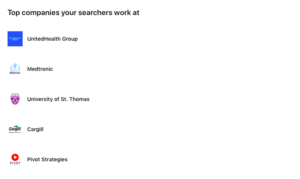For people who are “on LinkedIn”, the experience is most likely an episodic one. Check in every once in a while. Make a few new connections each month. Post about your new job. For most people, that’s what LinkedIn is. They never look at their stats. Heck, they don’t even know where to find that stats.
However, if you’re one of those other people who want to use LinkedIn as a tool to help you get smarter and build out your network, you would be wise to look at your stats at least monthly because they can help you create better content and accomplish your goals.
Now, some people would say looking at your LinkedIn stats weekly or monthly is a little narcissitic. That it’s merely a way for you to “game the system” and become a bigger personality on LinkedIn. That it’s all part of the personal branding game.
I’d say that’s a pretty pessimistic view. What I would say is that if you’re taking LinkedIn seriously (and I believe most should), why wouldn’t you look at your stats monthly as a way to track your progress toward your goals (side note: I’m a huge goal guy).
So, I set out to conduct a four-week test of just that. To track my metrics on a weekly basis for four weeks as a way to learn more about how I’m doing on LinkedIn (side note: I’ve been doing this for years)–and figure out ways to improve or refine my approach in the months ahead.
First, the stats. I looked at my stats each Monday. Now, I have turned Creator Mode on, so I have more stats to view than the average user. But that’s probably lesson #1: TURN ON CREATOR MODE! The stats alone are worth it, and there is relatively no downside to doing it.
I looked at 5 stats each week:
- Followers (this matters for reach)
- Post impressions (ditto)
- Profile views (you want the right people to be interested in you)
- Search appearances (ditto)
- Engagements (who is interested in what you have to say)
Here are those stats over the last 4 weeks:
April 10
Followers – 5,842
Post impressions – 15,467 (past week)
Profile views – 1,721 (past 90 days)
Search appearances – 234 (past week)
Engagements – 283 (past week)
April 17
Followers – 5,877 (+35 from previous week)
Post impressions – 19,847 (+4,380)
Profile views – 1,755 (+34)
Search appearances – 296 (+62)
Engagements – 367 (+84)
April 24
Followers – 5,918 (+41)
Post impressions – 35,657 (+15,810)
Profile views – 1,809 (+54)
Search appearances – 365 (+69)
Engagements – 327 (-40)
May 1
Followers – 5,933 (+15)
Post impressions – 20,338 (-15,319)
Profile views – 1,205 (-604)
Search appearances – 258 (-107)
Engagements – 497 (+170)
Given those numbers, here’s what I learned:
Lesson #1: Search results/profile visits didn’t correlate with top performing content
My top-performing week from a content perspective (week 4) generated 497 engagements, my best week by more than 100 engagements. However, that didn’t translate into more searches or profile visits. I had 258 searches that week. Meanwhile, I had 365 the week before when I had 327 engagements. So, content performance does not necessarily translate into more people searching for you on LinkedIn. My theory: Searching has more to do with need. But, showing up consistently in the feed on LinkedIn contributes to the number of searches in the long run.
Lesson #2: The right people are searching for me
One of my goals with my LinkedIn work is to merely create more awareness for my name and what I do (social media marketing). My customers are largely PR, marketing or social folks with midsized to large companies in Minnesota. Those are the people I want searching for me on LinkedIn. And, it looks like that’s working! If you click on “searches” in your data, you’ll see the types of people searching for you. The people searching for me on LinkedIn work at these companies:

Almost perfect. UnitedHealth Group, Medtronic and Cargill all fall in that bucket. UST only shows up because that’s where I teach. Now let’s look at the typical job titles of people searching for me:

Again, almost perfect. I want specialist folks searching for me–they are often either my buyer or, in many cases, a big influencer of the buyer. Founders are obviously great–especially for referrals. And executive directors are good, too, as I’ve been working with more non-profit orgs of late.
Lesson #3: Timely topics, personal updates are what resonated the most
You know how everyone is complaining that LinkedIn is turning into Facebook? Well, apparently those people are in the minority because 3 of my top 5 posts in the last couple months have been personal updates. I talked about my son graduating high school (if you read the post, you know this is a much bigger deal than it sounds). I wrote about my car being stolen from right outside my front door in broad daylight. And I wrote about taking my son to a fancy dinner to celebrate a huge academic milestone. All 3 of these posts generated more than 10,000 impressions. On the other hand, my top 2 posts of the last couple months were posts relating to timely topics. Notably: NPR leaving Twitter (my top post in terms of reach) and a wonderful Red Wing Shoes campaign with a local non-profit. Note what was absent from my top 5 posts: Thought leadership. That is obviously a big part of my content mix on LinkedIn–but it’s not in my top 5. The lesson: It’s the vulnerable, personal and timely posts that are going to rope people in. They might see the other stuff, but you’ll gain a wider audience by opening up and talking about in-the-moment topics.
Lesson #4: Reach does not correlate with engagement success
Another interesting content lesson was that more impressions did not necessarily mean more engagements. In fact, some of my most engaging posts were nowhere near the top in terms of engagements. My top-performing post so far in 2023 was a post about the challenges of being a working adult trying to parent teens. That post generated almost 2,000 engagement–far and away my most engaging post of the year so far. You could say it ‘went viral’. However, that same post generated just 3,203 impressions–just over 10% of the number of impressions of my most successful post in 2023 in terms of reach. That post only had 140+ engagements. What’s happening here? Some of my most engaging posts were posts where I talked about either a personal topic or a topic specific to people who know me well (speaking at Social Media Breakfast for the first time in 3 years, for example). Meanwhile, some of my best posts in terms of reach tackled topics that would be relevant to virtually anyone–NPR quitting Twitter, the Red Wing Shoes case study, etc. The lesson here: Go topics/thought leadership for reach; go personal/local for depth.